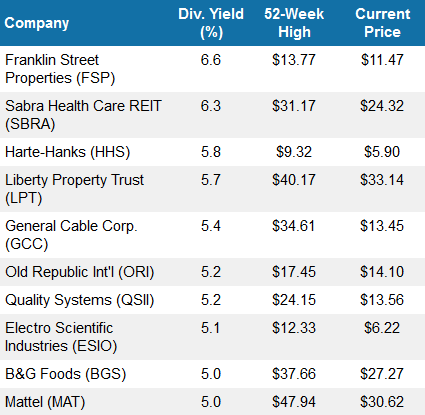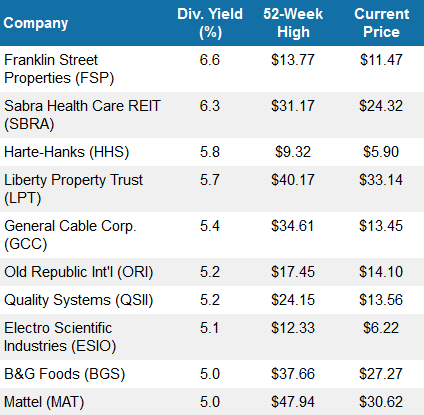By: David Sterman of Street Authority
In the early stages of the bull market, investors flocked to companies with steady and growing dividends. Yet, since the market began to think about an eventual rise in interest rates back in May 2013, this asset class has lost a bit of luster.
The concerns were quite logical: A steady rise in fixed-income yields naturally reduces the appeal of relatively riskier stocks.
But the emerging economic crisis in Europe changes everything. It's increasingly apparent that European economic troubles are here to stay for quite some time, which is likely to keep a lid on global interest rates. It's a bit of a goldilocks scenario for the U.S. economy, as low rates will help our economic recovery to expand without a rate rise headwind.
You would suspect that the pullback in interest rates would help provide support to dividend-paying stocks, but many of them haven't been able to escape the recent market rout. If you've been tracking divided payers but found their dividend yields to be too skimpy, you're in luck. The market slump pushed many 2% yielders into the 3% range, many 3% yielders into the 4% range, etc. In the context of falling fixed income yields, such dividend yields are now comparatively appealing again.
To be sure, this is not an invitation to focus on very high yields. I took a look at the top 10 dividend yields in the companies that comprise the SP 400, 500 and 600, and in most cases, real problems lie beneath surface. For example, telecommunication firms such NTELOS Holdings Corp. (Nasdaq: NTLS), Windstream Holdings, Inc. (NYSE: WIN) and Frontier Communications Corp. (NYSE: FTR) face eroding pricing and may be poised for a dividend cut. And current high yields among energy drillers and energy services companies are now quite vulnerable to a dividend cut, as oil prices shift onto a lower plane.

Instead it's wiser to focus on companies with merely respectable yields. Here's a group of 10 stocks (out of that universe of 1,500) that have seen their share prices fall by more than 20% and their dividend yields rise by a commensurate amount, to above 5%.

Toy and games maker Mattel, Inc. (NYSE: MAT) is precisely the kind of opportunity you can seek out in this market environment. The company has boosted its dividend at a double-digit pace for each of the past four years, and its current 5% yield is the highest it has been in recent memory.
Mattel is having an off-year with sales expected to be flat and per share profits expected to fall by more than 10%, to around $2.15 a share. Though Mattel generates robust cash flow and the current dividend is quite safe, management may also take advantage of the share price weakness by initiating a share buyback program when Q3 results are released. Back in 2008, when shares last hit a major air pocket, Mattel put a $500 million buyback plan in place.
Investors may also want to re-visit Sabra Health Care REIT, Inc. (Nasdaq: SBRA), which has a remarkably stable business model, acting as landlord to many economically-insensitive health care offices. Thanks to a recent acquisition, Sabra is expected to boost per share profits to $2.40 by next year from around $1.85 in 2013. This suggests that the current dividend will get a decent boost in 2015, as REITs must pay out most of their income in the form of dividends.
Though the group profiled above delivers yields in excess of 5%, there are also many other stocks that have pulled back recently and now sport solid yields in the 4%-to-5% range. They include:
Plum Creek Timber Co., Inc. (NYSE: PCL), which should be a beneficiary of the eventual rebound in new home construction and now sports a 4.4% yield.
Homebuilder MDC Holdings, Inc. (NYSE: MDC), which, as I noted a few weeks ago, trades for right around book value and also offers an industry-leading 4.0% dividend yield.
Big Five Sporting Goods Corp. (Nasdaq: BGFV), which has fallen more than 50% from its 52-week high, offers a 4.2% dividend yield and should benefit from an upturn in consumer discretionary spending as employment trends strengthen.
Risks to Consider: As we've seen, a decent dividend yield hasn't insulated these stocks from the broader market weakness, though the now-higher yields should help them play better defense in the quarters ahead.
Action to Take -- The pullback in interest rates, along with the likelihood that they won't be rebounding any time soon, is likely to compel investors to give dividend-paying stocks a fresh look. These investments all offer compelling yields. Of the stocks profiled, Mattel and MDC Holdings hold especially strong appeal.
In the past year, Street Authority recommendations on individual stocks have gained +72%, +26% and +60% all in less than six months... and recently, their trades could have made you +26% in 42 days and +42% in less than one month. Click here to get the free trading advisory -- Trade of the Week.

Hi i have trade my stock from Emperor thank